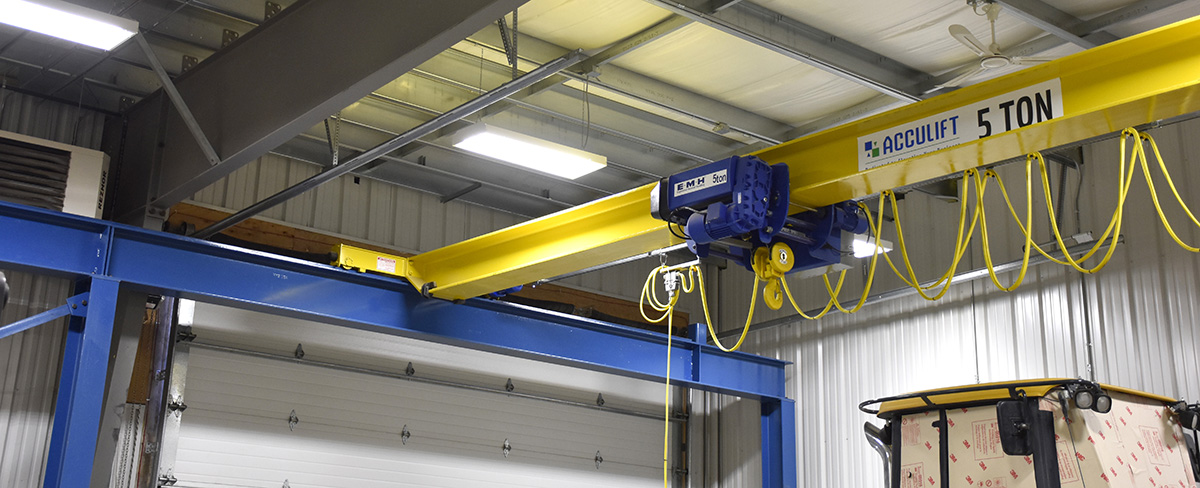
06 Aug CMAA Crane Duty Classifications explained
Here’s what you need to know about CMAA crane classifications in Canada.
CMAA is the Crane Manufacturers Association of America, Inc., an independent trade association affiliated with the Material Handling Industry. CMAA traces its roots to the Electric Overhead Crane Institute, known as EOCI, which was founded in 1927 by leading crane manufacturers of that time to promote the standardization of cranes as well as uniform quality and performance. The voluntary association was incorporated as the Crane Manufacturers Association of America, Inc. in 1955. Member Companies, representing the industry leaders in the overhead crane industrycome from the United States, Canada, and Mexico.
CMAA has set up a standard for crane classifications that are used to help define the use of a crane. These standards are based on capacity and usage and help us to select the right hoist and crane for your operations. Accepted as the industry norm in Canada, US, and Mexico they help to insure standards are in place across manufacturer’s and installers, which ensures that the end user has a crane lifting system that matches their needs.
CMAA Crane Duty Classifications
| Crane Classification | Typical Installation | # Lifts per/hr. | Average Lift | Shift | Typical Workload | Key Points |
|---|---|---|---|---|---|---|
| Class A Standby or Infrequent Service | Power Houses Public Utilites Turbine Rooms Motor Rooms Transformer Stations | 0 – 2 | 10 ft. | Single Shift Operation |
|
|
| Class B Light Service | Repair Shops Light Assembly Operations Light Warehousing | 2 – 5 | 10 ft. | Single Shift Operation |
|
|
| Class C Moderate Service | Machine Shops Paper Mills Machine Rooms | 5 – 10 | 15 ft. | Single Shift Operation |
|
|
| Class D Heavy Service | Heavy Machine Shops Foundries Fabricating Plants Steel Warehouses Container Yards Lumber Mills Stanadard Duty Bucket & Magnet Operations | 10 – 20 | 15 ft. | 1 – 2 Shift Operation |
|
A Built-Up Hoist is typically used in this type of application and is tailored towards a specific application with a heavy duty cycle to handle demanding needs. |
| Class E Severe Service | Magnet Bucket Magnet/Bucket Combo Scrap Yards Cement Mills Lumber Mills Fertilizer Plans Container Handling | 20+ | 20+ ft. | 24/7 Continuously |
|
A Built-Up Hoist is typically used in this type of application and is tailored towards a specific application with a heavy duty cycle to handle demanding needs. |
Each classification above is determined by the criteria below. If you know where your requirements are in this criteria you can determine the type of overhead crane that works best for you individual lifting needs.
Speed
How quickly can the crane move materials or equipment and how many lifts per hour can the crane perform
Service
How often will your crane be used?
Maintenance
How much maintenance is expected for the lifetime of the system?
Distance
How far does the crane need to move materials?
Rated Capacity
What will be the average load weight of the materials that you will be lifting? How often will the crane be moving full capacity loads?
Environment
What type of service conditions will the crane be operating in?
And knowing the expected Duty Cycle of your crane enables us to select the optimal hoist for your system.
Hoist Classification | Corresponding Crane Class | ||||
| FEM | HMI | ISO | CMAA | DIN 15018 & SIM. | Example |
|---|---|---|---|---|---|
| 1Cm | H1 | M2 | CLASS A | H1/B2 |
|
| 1Bm | H2 | M3 | CLASS B | H1/B2 |
|
| 1Am | H3 | M4 | CLASS C | H2/B3 |
|
| 2m | H4 | M5 | CLASS D | H2/B3 |
|
| 3m | H4 | M6 | CLASS D | H2/B3 or H3/B4 |
|
| 4m | H4 or H5 | M7 | CLASS D or CLASS E | H3/B4 or H4/H6 |
|
FEM – Federation Europeenne de la Manutention
(European Federation of Material Handling)
HMI – Hoist Manufacturers Institute
ISO – International Organization for Standardization
CMAA – Crane Manufacturers Association of America
DIN – Federation Europeenne de la Manutention
(German Institute for Standardization)
Need some expert advice?
Call us at (204) 837 8367 or Toll Free at 1 888 317 8880 to talk to a representative.



